

character special – a kind of device file.

pipe – special file that connects the output of one process to the input of another.socket – special kind of file used for inter-process communication.symbolic link – special kind of file that contains a reference to another file or directory.Where the string exfxcxdxbxegedabagacad is a concatenation of pairs of the format TB, where T is the text color and B is the Background color. Now, let’s learn how we can configure our Terminal to obtain the colors of the figure.Ĭolors can be changed using the LSCOLORS variable in the ~/.bash_profile. Save the file, and activate the changes like before. You only need to open the ~/.bash_profile file and add the following line: Source ~/.bash_profile Activate colors in your TerminalĪctivate colors is very easy. To activate these changes open and close the terminal, or run You can find more information about these special characters in this link. \h \W indicates the format of the prompt: path.Where the first line is a comment indicating the default value, and To change the color of the Terminal prompt to a green color, open or create the file ~/.bash_profile and \W]\$ ‘ # \W]\$\ ‘ It also covers how to activate the Terminal color layout, a very useful feature that displays different colors depending on the character of the file or folder. I do not yet have enough Unix experience to guide you from here.This post explains how you can change the color of the Terminal prompt in Mac OS X. Hence I suggest try: ch.sudo.cyberduck ~/Public/"Dropbox (Personal)"Īs for the rest of this command, I am not sure that ch is a valid Unix command. To reference a folder in the image below, for example, the following referencing works for the cd (change directory command): This makes it easier to humanly type the correct reference. Even though there are brackets in the name, there is no need to escape these characters in Unix in Terminal in this instance when using double quotation marks. Dragging the folder into the Terminal window current command line will automatically give you the correct referencing to that folder.Īs an alternative I suggest putting the name of the folder in double quotation marks. Your current referencing to the folder would seem correct. I have set up a folder of the same name in my Public Folder to test as shown below. I am assuming you are using Unix in Terminal.



 0 kommentar(er)
0 kommentar(er)
